Assessing the PM2.5–O3 Correlation and Unraveling Their Drivers in Urban Environment: Insights from the Bohai Bay Region, China
Abstract
1. Introduction
2. Materials and Methods
2.1. Research Region
2.2. Data Sources
2.2.1. Criteria Air Pollutants
2.2.2. Super Station Observation Programs
2.2.3. Cloud Data
2.2.4. Quality Control and Quality Assurance
Quality Control of Monitoring Instruments
Data Quality Control
2.3. Data Processing
2.3.1. Identification of Primary Pollutants and Statistical Analysis of Polluted Days
2.3.2. Correlation Analysis
2.3.3. Quantification of Primary and Secondary PM2.5
2.3.4. Quantification of Organic Aerosol Mass Concentration
2.3.5. Objective Synoptic Classification
2.3.6. Sea–Land Breeze Identification Criteria
2.3.7. Random Forest
3. Results
3.1. Variation Patterns in PM2.5 and O3 Concentration Levels
3.1.1. Spatiotemporal Distribution Characteristics of PM2.5 and O3
3.1.2. Pollution Regime Characterization of PM2.5 and O3
3.1.3. Complex Pollution Characterization of PM2.5 and O3
3.2. Spatiotemporal Analysis of PM2.5 and O3 Correlation Characteristics
3.2.1. Temporal Variation in PM2.5 and O3 Correlation
3.2.2. Spatial Heterogeneity of PM2.5 and O3 Association
3.2.3. Pollution Level-Dependent Correlation Patterns
3.3. Impact Analysis of Meteorological Conditions
3.3.1. Synoptic Weather Patterns
3.3.2. Key Meteorological Parameters
Temperature
Humidity
Wind Speed
3.3.3. Sea–Land Breeze
3.4. Impact Analysis of Atmospheric Oxidative Capacity
3.4.1. Seasonal Modulation of Atmospheric Oxidation Potential
3.4.2. Diurnal Variation in Oxidizing Capacity
3.5. Concentration-Dependent Effects of PM2.5 and O3
3.6. Chemical Speciation Effects of PM2.5
3.7. Influence of Precursor Concentration Gradients
3.8. Random Forest-Based Importance Analysis of PM2.5 and O3 Drivers
4. Conclusions
Supplementary Materials
Author Contributions
Funding
Institutional Review Board Statement
Informed Consent Statement
Data Availability Statement
Conflicts of Interest
References
- Deng, C.; Tian, S.; Li, Z.; Li, K. Spatiotemporal Characteristics of PM2.5 and Ozone Concentrations in Chinese Urban Clusters. Chemosphere 2022, 295, 133813. [Google Scholar] [CrossRef] [PubMed]
- Xiao, X.N.; Yan, M.Z.; Lu, V.; Jia, H.Y.; Hang, M.; Qian, W.; Song, H.; Chao, H. Spatiotemporal Evolution Characteristics of PM2.5-O3 Compound Pollution in Chinese Cities from 2015 to 2020. Huanjing Kexue 2023, 44, 1830–1840. [Google Scholar]
- Duan, W.J.; Wang, X.Q.; Cheng, S.Y.; Wang, R.P. Regional Division and Influencing Mechanisms for the Collaborative Control of PM2.5 and O3 in China: A Joint Application of Multiple Mathematic Models and Data Mining Technologies. J. Clean. Prod. 2022, 337, 130607. [Google Scholar] [CrossRef]
- Dong, C.; Gao, R.; Zhang, X.; Li, H.; Wang, W.; Xue, L. Assessment of O3-Induced Crop Yield Losses in Northern China During 2013–2018 Using High-Resolution Air Quality Reanalysis Data. Atmos. Environ. 2021, 259, 118527. [Google Scholar] [CrossRef]
- Feng, Z.; De Marco, A.; Anav, A.; Gualtieri, M.; Sicard, P.; Tian, H.; Fornasier, F.; Tao, F.; Guo, A.; Paoletti, E. Economic Losses due to Ozone Impacts on Human Health, Forest Productivity and Crop Yield Across China. Environ. Int. 2019, 131, 104966. [Google Scholar] [CrossRef]
- Liu, C.; Chen, R.; Sera, F.; Vicedo-Cabrera, A.M.; Guo, Y.; Tong, S.; Lavigne, E.; Correa, P.M.; Ortega, N.V.; Achilleos, S. Interactive Effects of Ambient Fine Particulate Matter and Ozone on Daily Mortality in 372 Cities: Two Stage Time Series Analysis. BMJ 2023, 383, e075203. [Google Scholar] [CrossRef]
- He, C.; Liu, J.; Zhou, Y.; Zhou, J.; Zhang, L.; Wang, Y.; Liu, L.; Peng, S. Synergistic PM2.5 and O3 Control to Address the Emerging Global PM2.5-O3 Compound Pollution Challenges. Eco-Environ. Health 2024, 3, 325–337. [Google Scholar] [CrossRef]
- Liu, J.; He, C.; Si, Y.; Li, B.; Wu, Q.; Ni, J.; Zhao, Y.; Hu, Q.; Du, S.; Lu, Z. Toward Better and Healthier Air Quality: Global PM2.5 and O3 Pollution Status and Risk Assessment Based on the New WHO Air Quality Guidelines for 2021. Glob. Chall. 2024, 8, 2300258. [Google Scholar] [CrossRef]
- Yang, P.; Zhang, Y.; Wang, K.; Doraiswamy, P.; Cho, S.-H. Health Impacts and Cost-Benefit Analyses of Surface O3 and PM2.5 over the US under Future Climate and Emission Scenarios. Environ. Res. 2019, 178, 108687. [Google Scholar] [CrossRef]
- Wang, J.; Gao, A.; Li, S.; Liu, Y.; Zhao, W.; Wang, P.; Zhang, H. Regional Joint PM2.5-O3 Control Policy Benefits Further Air Quality Improvement and Human Health Protection in Beijing–Tianjin–Hebei and Its Surrounding Areas. J. Environ. Sci. 2023, 130, 75–84. [Google Scholar] [CrossRef]
- Awe, Y.A.; Larsen, B.K.; Sanchez-Triana, E. The Global Health Cost of PM2.5 Air Pollution: A Case for Action Beyond 2021; World Bank Group: Washington, DC, USA, 2022. [Google Scholar]
- Selin, N.E.; Wu, S.; Nam, K.-M.; Reilly, J.M.; Paltsev, S.; Prinn, R.G.; Webster, M.D. Global Health and Economic Impacts of Future Ozone Pollution. Environ. Res. Lett. 2009, 4, 044014. [Google Scholar] [CrossRef]
- Lanzi, E. The Economic Consequences of Outdoor Air Pollution; Organization for Economic Cooperation and Development: Paris, France, 2016. [Google Scholar]
- Xie, Y.; Dai, H.; Zhang, Y.; Wu, Y.; Hanaoka, T.; Masui, T. Comparison of Health and Economic Impacts of PM2.5 and Ozone Pollution in China. Environ. Int. 2019, 130, 104881. [Google Scholar] [CrossRef]
- Xu, X. Recent Advances in Studies of Ozone Pollution and Impacts in China: A Short Review. Curr. Opin. Environ. Sci. Health 2021, 19, 100225. [Google Scholar] [CrossRef]
- Meng, Z.; Dabdub, D.; Seinfeld, J.H. Chemical Coupling Between Atmospheric Ozone and Particulate Matter. Science 1997, 277, 116–119. [Google Scholar] [CrossRef]
- Liao, H.; Zhou, Y.; Dai, H.; Gong, C. Influence of Weather and Climate Conditions on the Formation of Atmospheric PM2.5 and Ozone Pollution. Sci. Technol. Rev. 2022, 40, 41–48. [Google Scholar]
- Qu, Y.; Wang, T.; Wu, H.; Shu, L.; Li, M.; Chen, P.; Zhao, M.; Li, S.; Xie, M.; Zhuang, B.; et al. Vertical Structure and Interaction of Ozone and Fine Particulate Matter in Spring at Nanjing, China: The Role of Aerosol’s Radiation Feedback. Atmos. Environ. 2020, 222, 117162. [Google Scholar] [CrossRef]
- Zhang, Y.; Zhao, T.; Yin, C.; Wang, Z.; Ge, B.; Liu, R.; Du, X. Seasonal Variation of the Relationship Between Surface PM2.5 and O3 Concentrations in Xuzhou. China Environ. Sci. 2019, 39, 2267–2272. [Google Scholar]
- Jia, C.; Tong, S.; Zhang, X.; Li, F.; Zhang, W.; Li, W.; Wang, Z.; Zhang, G.; Tang, G.; Liu, Z.; et al. Atmospheric Oxidizing Capacity in Autumn Beijing: Analysis of the O3 and PM2.5 Episodes Based on Observation-Based Model. J. Environ. Sci. 2023, 124, 557–569. [Google Scholar] [CrossRef]
- Li, K.; Jacob, D.J.; Liao, H.; Zhu, J.; Shah, V.; Shen, L.; Bates, K.H.; Zhang, Q.; Zhai, S. A Two-Pollutant Strategy for Improving Ozone and Particulate Air Quality in China. Nat. Geosci. 2019, 12, 906–910. [Google Scholar] [CrossRef]
- Ye, H.; Jun, M.Y.; Cong, S.C.; Feng, W.Y.; Hui, R.W.; Kang, W.J.; Dong, W.D.; Bin, X.X. Analysis of the Relationship between O3 and PM2.5 and the Main Factors Controlling Air Pollution in Shenyang. Sci. Technol. Rev. 2024, 37, 455–468. [Google Scholar]
- Yang, J.; Wen, Y.; Wang, Y.; Zhang, S.; Pinto, J.P.; Pennington, E.A.; Wang, Z.; Wu, Y.; Sander, S.P.; Jiang, J.H. From COVID-19 to Future Electrification: Assessing Traffic Impacts on Air Quality by a Machine-Learning Model. Proc. Natl. Acad. Sci. USA 2021, 118, e2102705118. [Google Scholar] [CrossRef]
- Yadav, R.K.; Gadhavi, H.; Arora, A.; Mohbey, K.K.; Kumar, S.; Lal, S.; Mallik, C. Relation Between PM2.5 and O3 over Different Urban Environmental Regimes in India. Urban Sci. 2023, 7, 9. [Google Scholar] [CrossRef]
- Jia, M.; Zhao, T.; Cheng, X.; Gong, S.; Zhang, X.; Tang, L.; Liu, D.; Wu, X.; Wang, L.; Chen, Y. Inverse Relations of PM2.5 and O3 in Air Compound Pollution between Cold and Hot Seasons over an Urban Area of East China. Atmosphere 2017, 8, 59. [Google Scholar] [CrossRef]
- Qiu, Y.; Wu, Z.; Shang, D.; Zhang, Z.; Xu, N.; Zong, T.; Zhao, G.; Tang, L.; Guo, S.; Wang, S. The Temporal and Spatial Distribution of the Correlation Between PM2.5 and O3 Contractions in the Urban Atmosphere of China. Chin. Sci. Bull. 2022, 67, 2008–2017. [Google Scholar] [CrossRef]
- Qiu, P.; Zhang, L.; Wang, X.; Liu, Y.; Wang, S.; Gong, S.; Zhang, Y. A New Approach of Air Pollution Regionalization Based on Geographically Weighted Variations for Multi-Pollutants in China. Sci. Total Environ. 2023, 873, 162431. [Google Scholar] [CrossRef] [PubMed]
- Zhu, J.; Chen, L.; Liao, H.; Dang, R. Correlations Between PM2.5 and Ozone over China and Associated Underlying Reasons. Atmosphere 2019, 10, 352. [Google Scholar] [CrossRef]
- Chen, J.; Shen, H.; Li, T.; Peng, X.; Cheng, H.; Ma, C. Temporal and Spatial Features of the Correlation between PM2.5 and O3 Concentrations in China. Int. J. Environ. Res. Public Health 2019, 16, 4824. [Google Scholar] [CrossRef]
- Wang, L.; Zhao, B.; Zhang, Y.; Hu, H. Correlation Between Surface PM2.5 and O3 in Eastern China During 2015–2019: Spatiotemporal Variations and Meteorological Impacts. Atmos. Environ. 2023, 294, 119520. [Google Scholar] [CrossRef]
- Tian, L.; Jiao, Y.W.; Peng, L.Z.; Rui, L.; Yong, F.; Na, Z.L.; Kang, F.W. Comparison of PM2.5 and O3 Pollution Changes in Inland and Coastal Megacities in Shandong Province. EST China 2023, 36, 47–52+69. [Google Scholar]
- Hong, M.L.; Hua, L.Y.; Qin, H.S.; Yi, H.T. Influence of Sea-Land Breeze on the Concentrations of PM2.5 and O3 in Tianjin City. Sci. Technol. Rev. 2019, 32, 390–398. [Google Scholar]
- Wang, B.; Zhang, C.; Huang, L.; Zhang, G.; Yuan, X.; Yao, R.; Zhang, M. Spatiotemporal Assessment of Atmospheric Pollutants in Yancheng City, Eastern Coastal City of China. Atmosphere 2023, 14, 851. [Google Scholar] [CrossRef]
- Zhan, Y.; Luo, Y.; Deng, X.; Grieneisen, M.L.; Zhang, M.; Di, B. Spatiotemporal Prediction of Daily Ambient Ozone Levels across China Using Random Forest for Human Exposure Assessment. Environ. Pollut. 2018, 233, 464–473. [Google Scholar] [CrossRef] [PubMed]
- Tie, X.; Wu, D.; Brasseur, G. Lung Cancer Mortality and Exposure to Atmospheric Aerosol Particles in Guangzhou, China. Atmos. Environ. 2009, 43, 2375–2377. [Google Scholar] [CrossRef]
- Fei, L.; Xiugen, F.; Jian, W.; Chunyan, S. Mechanism of Organic Matter Accumulation in a Marine-Terrestrial Transitional Residual Bay Environment: A Case of Early Cretaceous Organic-Rich Shales in the Qiangtang Basin. China Geol. 2023, 50, 1093–1106. [Google Scholar]
- Hou, L.; Luo, X.; Yu, Z.; Wu, S.; Zhao, Z.; Lin, S. Key Factors Controlling the Occurrence of Shale Oil and Gas in the Eagle Ford Shale, the Gulf Coast Basin: Models for Sweet Spot Identification. J. Nat. Gas Sci. Eng. 2021, 94, 104063. [Google Scholar] [CrossRef]
- Guo, W.; Yang, Y.; Chen, Q.; Zhu, Y.; Zhang, Y.; Zhang, Y.; Liu, Y.; Li, G.; Sun, W.; She, J. Chemical Reactivity of Volatile Organic Compounds and Their Effects on Ozone Formation in a Petrochemical Industrial Area of Lanzhou, Western China. Sci. Total Environ. 2022, 839, 155901. [Google Scholar] [CrossRef]
- Zhao, M.; Shen, H.Q.; Chen, T.S.; Li, J.-D.; Sun, Z.Q.; Ji, Y.Y.; Xue, L.K.; Li, H.; Wang, W.X.; Shang, F.Y. Characteristics and Sensitivity Analysis of Ozone in the Representative City of the Yellow River Delta in Summer. Sci. Technol. Rev. 2022, 35, 1351–1361. [Google Scholar]
- Lin, W. Volatile Organic Compound Emissions from the Oilfield in the Yellow River Delta Region, Northern China and Their Impact on Regional Ozone Pollution. Master’s Thesis, Shandong University, Jinan, China, 2019. [Google Scholar]
- Chen, L.; Zhu, J.; Liao, H.; Yang, Y.; Yue, X. Meteorological Influences on PM2.5 and O3 Trends and Associated Health Burden since China’s Clean Air Actions. Sci. Total Environ. 2020, 744, 140837. [Google Scholar] [CrossRef]
- Qiang, B.H. Characterization of Secondary Components in PM2.5 and Traceability Study Based on CMB-CMAQ Modeling in Jinan City. Master’s Thesis, Shandong Jianzhu University, Jinan, China, 2023. [Google Scholar]
- Ji, Y.; An, C.; Tang, J.; Li, J.; Yan, X.; Gao, X.; Chu, W.; Zhong, X.; Shang, F.; Li, J. Causes Investigation of PM2.5 and O3 Complex Pollution in a Typical Coastal City in the Bohai Bay Region of China in Autumn: Based on One-Month Continuous Intensive Observation and Model Simulation. Atmosphere 2024, 15, 73. [Google Scholar] [CrossRef]
- HJ 818-2018; Technical Specifications for Operation and Quality Control of Ambient Air Quality Continuous Automated Monitoring System for SO2, NO2, O3 and CO. Ministry of Ecology and Environment of the People’s Republic of China: Beijing, China, 2018.
- QX/T 70-2007; Determination of Elemental Carbon and Organic Carbon in Atmospheric Aerosols—Thermal-Optical Analysis Method. China Meteorological Administration: Beijing, China, 2007.
- HJ/T 193-2005; Automated Methods for Ambient Air Quality Monitoring. State Environmental Protection Administration: Beijing, China, 2005.
- HJ 1010-2018; Specifications and Test Procedures for Ambient Air Quality Continuous Monitoring System with Gas Chromatography for Volatile Organic Compounds. Ministry of Ecology and Environment of the People’s Republic of China: Beijing, China, 2019.
- HJ 1327-2023; Technical Specifications for Continuous Automated Monitoring of Organic Carbon and Elemental Carbon in Ambient Air Particulate Matter (PM2.5). Ministry of Ecology and Environment of the People’s Republic of China: Beijing, China, 2024.
- HJ 1328-2023; Technical Specifications for Continuous Automated Monitoring of Water-Soluble Ions in Ambient Air Particulate Matter (PM2.5). Ministry of Ecology and Environment of the People’s Republic of China: Beijing, China, 2024.
- HJ 1329-2023; Technical Specifications for Continuous Automated Monitoring of Inorganic Elements in Ambient Air Particulate Matter (PM2.5). Ministry of Ecology and Environment of the People’s Republic of China: Beijing, China, 2024.
- GB 3095-2012; Ambient Air Quality Standards. Ministry of Ecology and Environment of the People’s Republic of China: Beijing, China, 2016.
- HJ 663-2013; Technical Regulation for Ambient Air Quality Assessment (on Trial). Ministry of Ecology and Environment of the People’s Republic of China: Beijing, China, 2013.
- HJ 663-2012; Technical Regulation on Ambient Air Quality Index (on Trial). Ministry of Ecology and Environment of the People’s Republic of China: Beijing, China, 2016.
- Li, H.; Wang, Y.; Huang, L.; Liu, Z.; Wang, W.; Feng, J. Analysis of Synergistic Growth Effects between Ozone and Secondary Aerosol in Typical Cities in China. Acta Sci. Circumstantiae 2020, 40, 4368–4379. [Google Scholar]
- Chow, J.C.; Watson, J.G.; Lu, Z.; Lowenthal, D.H.; Frazier, C.A.; Solomon, P.A.; Thuillier, R.H.; Magliano, K. Descriptive Analysis of PM2.5 and PM10 at Regionally Representative Locations During SJVAQS/AUSPEX. Atmos. Environ. 1996, 30, 2079–2112. [Google Scholar] [CrossRef]
- Ivatt, P.D.; Evans, M.J.; Lewis, A.C. Suppression of Surface Ozone by an Aerosol-Inhibited Photochemical Ozone Regime. Nat. Geosci. 2022, 15, 536–540. [Google Scholar] [CrossRef]
- Cheng, M.Z.; Ming, X.J.; Hao, Q.Y.; Qin, Y.C.; Dan, Y.D.; Qiang, Z.G. Classification Characteristics, Circulation Background and Its Effect on O3 of Land and Sea Breeze in Shanghai. China Environ. Sci. 2023, 43, 1002–1013. [Google Scholar]
- Zeren, Y.; Zhou, B.; Zheng, Y.; Jiang, F.; Lyu, X.; Xue, L.; Wang, H.; Liu, X.; Guo, H. Does Ozone Pollution Share the Same Formation Mechanisms in the Bay Areas of China? Sci. Total Environ. 2022, 56, 14326–14337. [Google Scholar] [CrossRef]
- An, C.; Ji, Y.-Y.; Chu, W.-H.; Yan, X.-Y.; Bi, F.; Gao, R.; Xue, L.-K.; Shang, F.-Y.; Li, J.-D.; Li, H. Spatiotemporal Distribution Characteristics of Ground-Level-Ozone and Its Relationship with Meteorological Conditions in a Representative City in the Bohai Rim from 2017 to 2022. Huanjing Kexue 2024, 45, 4398–4410. [Google Scholar] [PubMed]
- Breiman, L. Random Forests. Mach. Learn. 2001, 45, 5–32. [Google Scholar] [CrossRef]
- Shang, Y.J.; Mao, Y.H.; Liao, H.; Hu, J.L.; Zou, Z.Y. Response of PM2.5 and O3 to Emission Reductions in Nanjing Based on Random Forest Algorithm. Huanjing Kexue 2023, 44, 4250–4261. [Google Scholar] [PubMed]
- Liu, Y.; Cai, Q.; Tong, L.; Pan, Y.; Hu, S.; Zhu, X.; Gu, Z.; Zheng, J.; Wu, K.; Gong, Y.; et al. Influence of Sea-Land Breeze on the Variation Characteristics and Prediction of Ozone in the Suburbancoastal Atmosphere of Southeast Ningbo. Acta Sci. Circumst. 2023, 43, 27–39. [Google Scholar]
- Zhou, Z.; Qiu, C.; Zhang, Y. A Comparative Analysis of Linear Regression, Neural Networks and Random Forest Regression for Predicting Air Ozone Employing Soft Sensor Models. Sci. Rep. 2023, 13, 22420. [Google Scholar] [CrossRef]
- Qian, J.; Liao, H. Effectiveness of Precursor Emission Reductions for the Control of Summertime Ozone and PM2.5 in the Beijing–Tianjin–Hebei Region Under Different Meteorological Conditions. Adv. Atmos. Sci. 2024, 42, 653–669. [Google Scholar] [CrossRef]
- Chen, Z.; Zhuang, Y.; Xie, X.; Chen, D.; Cheng, N.; Yang, L.; Li, R. Understanding Long-Term Variations of Meteorological Influences on Ground Ozone Concentrations in Beijing During 2006–2016. Environ. Pollut. 2019, 245, 29–37. [Google Scholar] [CrossRef] [PubMed]
- Jing, Q.; Sheng, L.; Zhang, W.; An, X. Characteristics of PM2.5 and O3 Pollution and Related Meteorological Impacts in ‘2 + 26’ cities of Beijing–Tianjin–Hebei and Its Surrounding Areas from 2018 to 2021. Res. Environ. Sci. 2023, 36, 875–886. [Google Scholar]
- Long, J.; Shan, Y.S.; Fu, X.Y. Physicochemical Processes of a Typical Ozone Pollution in Suburb of Beijing. Chin. J. Atmos. Sci. 2024, 48, 391–404. [Google Scholar]
- Li, H.; Peng, L.; Bi, F.; Li, L.; Bao, J.; Li, J.; Zhang, H.; Chai, F. Strategy of Coordinated Control of PM2.5 and Ozone in China. Res. Environ. Sci. 2019, 32, 1763–1778. [Google Scholar]
- Wang, X.; Wu, Y.; Randel, W.; Tilmes, S. Stratospheric Contribution to the Summertime High Surface Ozone Events over the Western United States. Environ. Res. Lett. 2020, 15, 1040a6. [Google Scholar] [CrossRef]
- Hu, J.; Zhao, T.; Liu, J.; Cao, L.; Wang, C.; Li, Y.; Shi, C.; Tan, C.; Sun, X.; Shu, Z.; et al. Exploring the Ozone Pollution over the Western Sichuan Basin, Southwest China: The Impact of Diurnal Change in Mountain-Plains Solenoid. Sci. Total Environ. 2022, 839, 156264. [Google Scholar] [CrossRef]
- Yang, L.M.; Wang, S.B.; Hao, Q.; Han, S.J.; Li, C.; Zhao, Q.Y.; Yan, Q.S.; Zhang, R.Q. Characteristics and Source Analysis of water-Soluble Ions in PM2.5 in Zhengzhou. Huanjing Kexue 2019, 40, 2977–2984. [Google Scholar]
- Jiang, N.; Guo, Y.; Wang, Q.; Kang, P.; Zhang, R.; Tang, X. Chemical Composition Characteristics of PM2.5 in Three Cities in Henan, Central China. Aerosol Air Qual. Res. 2017, 17, 2367–2380. [Google Scholar] [CrossRef]
- Ram, K.; Sarin, M.M. Day-Night Variability of EC, OC, WSOC and Inorganic Ions in Urban Environment of Indo-Gangetic Plain: Implications to Secondary Aerosol Formation. Atmos. Environ. 2011, 45, 460–468. [Google Scholar] [CrossRef]
- Shao, P.; Xin, J.; An, J.; Wang, J.; Wu, F.; Wang, Y. An Analysis on the Relationship between Ground-Level Ozone and Particulate Matter in an Industrial Area in the Yangtze River Delta During Summer Time. Chin. J. Atmos. Sci. 2017, 41, 618–628. [Google Scholar]
- Zhang, R.; Sun, X.; Shi, A.; Huang, Y.; Yan, J.; Nie, T.; Yan, X.; Li, X. Secondary Inorganic Aerosols Formation During Haze Episodes at an Urban Site in Beijing, China. Atmos. Environ. 2018, 177, 275–282. [Google Scholar] [CrossRef]
- Sievering, H.; Boatman, J.; Galloway, J.; Keene, W.; Kim, Y.; Luria, M.; Ray, J. Heterogeneous Sulfur Conversion in Sea-Salt Aerosol Particles: The Role of Aerosol Water Content and Size Distribution. Atmos. Environ. Part A Gen. Top. 1991, 25, 1479–1487. [Google Scholar] [CrossRef]
- Fang, Y.; Ye, C.; Wang, J.; Wu, Y.; Hu, M.; Lin, W.; Xu, F.; Zhu, T. Relative Humidity and O3 Concentration as Two Prerequisites for Sulfate Formation. Atmos. Chem. Phys. 2019, 19, 12295–12307. [Google Scholar] [CrossRef]
- Han, Y.; Gong, Z.; Ye, J.; Liu, P.; McKinney, K.A.; Martin, S.T. Quantifying the Role of the Relative Humidity-Dependent Physical State of Organic Particulate Matter in the Uptake of Semivolatile Organic Molecules. Environ. Sci. Technol. 2019, 53, 13209–13218. [Google Scholar] [CrossRef] [PubMed]
- Luo, H.; Jia, L.; Wan, Q.; An, T.; Wang, Y. Role of Liquid Water in the Formation of O3 and SOA Particles from 1,2,3-Trimethylbenzene. Atmos. Environ. 2019, 217, 116955. [Google Scholar] [CrossRef]
- Möller, D. Atmospheric Hydrogen Peroxide: Evidence for Aqueous-Phase Formation from a Historic Perspective and a One-Year Measurement Campaign. Atmos. Environ. 2009, 43, 5923–5936. [Google Scholar] [CrossRef]
- Herrmann, H.; Schaefer, T.; Tilgner, A.; Styler, S.A.; Weller, C.; Teich, M.; Otto, T. Tropospheric Aqueous-Phase Chemistry: Kinetics, Mechanisms, and Its Coupling to a Changing Gas Phase. Chem. Rev. 2015, 115, 4259–4334. [Google Scholar] [CrossRef]
- Cao, Y.; Liu, J.; Ma, Q.; Zhang, C.; Zhang, P.; Chen, T.; Wang, Y.; Chu, B.; Zhang, X.; Francisco, J.S.; et al. Photoactivation of Chlorine and Its Catalytic Role in the Formation of Sulfate Aerosols. J. Am. Chem. Soc. 2024, 146, 1467–1475. [Google Scholar] [CrossRef]
- Su, T. Isotope Based Source Apportionment of Atmospheric Nitrate and Its Application to Source Apportionment of PM2.5 in the Pearl River Delta. Ph.D. Thesis, University of Chinese Academy of Sciences, Beijing, China, 2022. [Google Scholar]
- Lee, B.-K.; Choi, S.-D.; Shin, B.; Kim, S.-J.; Lee, S.-J.; Kim, D.-G.; Lee, G.; Kang, H.-J.; Kim, H.-S.; Park, D.-Y. Sensitivity Analysis of Volatile Organic Compounds to PM2.5 Concentrations in a Representative Industrial City of Korea. Asian J. Atmos. Environ. 2023, 17, 3. [Google Scholar] [CrossRef]
- Ye, S.; Ma, T.; Duan, F.; Li, H.; He, K.; Xia, J.; Yang, S.; Zhu, L.; Ma, Y.; Huang, T. Characteristics and Formation Mechanisms of Winter Haze in Changzhou, a Highly Polluted Industrial City in the Yangtze River Delta, China. Environ. Pollut. 2019, 253, 377–383. [Google Scholar] [CrossRef]
- Wang, Y.; Zhang, Q.; Jiang, J.; Zhou, W.; Wang, B.; He, K.; Duan, F.; Zhang, Q.; Philip, S.; Xie, Y. Enhanced Sulfate Formation During China’s Severe Winter Haze Episode in January 2013 Missing from Current Models. J. Geophys. Res.-Atmos. 2014, 119, 10,425–10,440. [Google Scholar] [CrossRef]
- Zheng, B.; Zhang, Q.; Zhang, Y.; He, K.; Wang, K.; Zheng, G.; Duan, F.; Ma, Y.; Kimoto, T. Heterogeneous Chemistry: A Mechanism Missing in Current Models to Explain Secondary Inorganic Aerosol Formation During the January 2013 Haze Episode in North China. Atmos. Chem. Phys. 2015, 15, 2031–2049. [Google Scholar] [CrossRef]
- Hong, Y.; Ma, Y.; Sun, J.; Li, C.; Zhang, Y.; Li, X.; Zhou, D.; Wang, Y.; Liu, N. Water-Soluble Ion Components of PM10 During the Winter-Spring Season in a Typical Polluted City in Northeast China. Environ. Sci. Pollut. Res. 2019, 26, 7055–7070. [Google Scholar] [CrossRef]
- Wang, Y.; Pavuluri, C.M.; Fu, P.; Li, P.; Dong, Z.; Xu, Z.; Ren, H.; Fan, Y.; Li, L.; Zhang, Y.-L.; et al. Characterization of Secondary Organic Aerosol Tracers over Tianjin, North China during Summer to Autumn. ACS Earth Space Chem. 2019, 3, 2339–2352. [Google Scholar] [CrossRef]
- Li, X.; Bei, N.; Hu, B.; Wu, J.; Pan, Y.; Wen, T.; Liu, Z.; Liu, L.; Wang, R.; Li, G. Mitigating NOX Emissions Does Not Help Alleviate Wintertime Particulate Pollution in Beijing-Tianjin-Hebei, China. Environ. Pollut. 2021, 279, 116931. [Google Scholar] [CrossRef]
- Wang, Z.; Wang, R.; Wang, J.; Wang, Y.; McPherson Donahue, N.; Tang, R.; Dong, Z.; Li, X.; Wang, L.; Han, Y.; et al. The Seasonal Variation, Characteristics and Secondary Generation of PM2.5 in Xi’an, China, Especially During Pollution Events. Environ. Res. 2022, 212, 113388. [Google Scholar] [CrossRef] [PubMed]
- Zhang, J.; Liu, L.; Xu, L.; Lin, Q.; Zhao, H.; Wang, Z.; Guo, S.; Hu, M.; Liu, D.; Shi, Z. Exploring Wintertime Regional Haze in Northeast China: Role of Coal and Biomass Burning. Atmos. Chem. Phys. 2020, 20, 5355–5372. [Google Scholar] [CrossRef]
- Jacob, D.J. Heterogeneous Chemistry and Tropospheric Ozone. Atmos. Environ. 2000, 34, 2131–2159. [Google Scholar] [CrossRef]
- An, C.; Li, H.; Ji, Y.; Chu, W.; Yan, X.; Chai, F. A Review on Nocturnal Surface Ozone Enhancement: Characterization, Formation Causes, and Atmospheric Chemical Effects. Sci. Total Environ. 2024, 921, 170731. [Google Scholar] [CrossRef]
- Zhao, M.; Zhang, Y.; Pei, C.; Chen, T.; Mu, J.; Liu, Y.; Wang, Y.; Wang, W.; Xue, L. Worsening Ozone Air Pollution with Reduced NOx and VOCs in the Pearl River Delta Region in Autumn 2019: Implications for National Control Policy in China. J. Environ. Manag. 2022, 324, 116327. [Google Scholar] [CrossRef]
- Seinfeld, J.H.; Pandis, S.N. Atmospheric Chemistry and Physics: From Air Pollution to Climate Change; John Wiley & Sons: Hoboken, NJ, USA, 2016. [Google Scholar]
- Shao, M.; Wang, W.; Yuan, B.; Parrish, D.D.; Li, X.; Lu, K.; Wu, L.; Wang, X.; Mo, Z.; Yang, S. Quantifying the Role of PM2.5 Dropping in Variations of Ground-Level Ozone: Inter-Comparison between Beijing and Los Angeles. Sci. Total Environ. 2021, 788, 147712. [Google Scholar] [CrossRef]
- Kroll, J.H.; Seinfeld, J.H. Chemistry of Secondary Organic Aerosol: Formation and Evolution of Low-Volatility Organics in the Atmosphere. Atmos. Environ. 2008, 42, 3593–3624. [Google Scholar] [CrossRef]
- Zhang, Q.; Jimenez, J.L.; Canagaratna, M.; Allan, J.D.; Coe, H.; Ulbrich, I.; Alfarra, M.; Takami, A.; Middlebrook, A.; Sun, Y. Ubiquity and Dominance of Oxygenated Species in Organic Aerosols in Anthropogenically-Influenced Northern Hemisphere Midlatitudes. Geophys. Res. Lett. 2007, 34, 13. [Google Scholar] [CrossRef]
- Kroll, J.H.; Ng, N.L.; Murphy, S.M.; Flagan, R.C.; Seinfeld, J.H. Secondary Organic Aerosol Formation from Isoprene Photooxidation. Environ. Sci. Technol. 2006, 40, 1869–1877. [Google Scholar] [CrossRef]
- Li, Y.; Wang, T.; Wang, Q.g.; Li, M.; Qu, Y.; Wu, H.; Xie, M. Impact of Aerosol-Radiation Interaction and Heterogeneous Chemistry on the Winter Decreasing PM2.5 and Increasing O3 in Eastern China 2014–2020. J. Environ. Sci. 2025, 151, 469–483. [Google Scholar] [CrossRef]
- Liang, C.S.; Duan, F.K.; He, K.B.; Ma, Y.L. Review on Recent Progress in Observations, Source Identifications and Countermeasures of PM2.5. Environ. Int. 2016, 86, 150–170. [Google Scholar] [CrossRef]
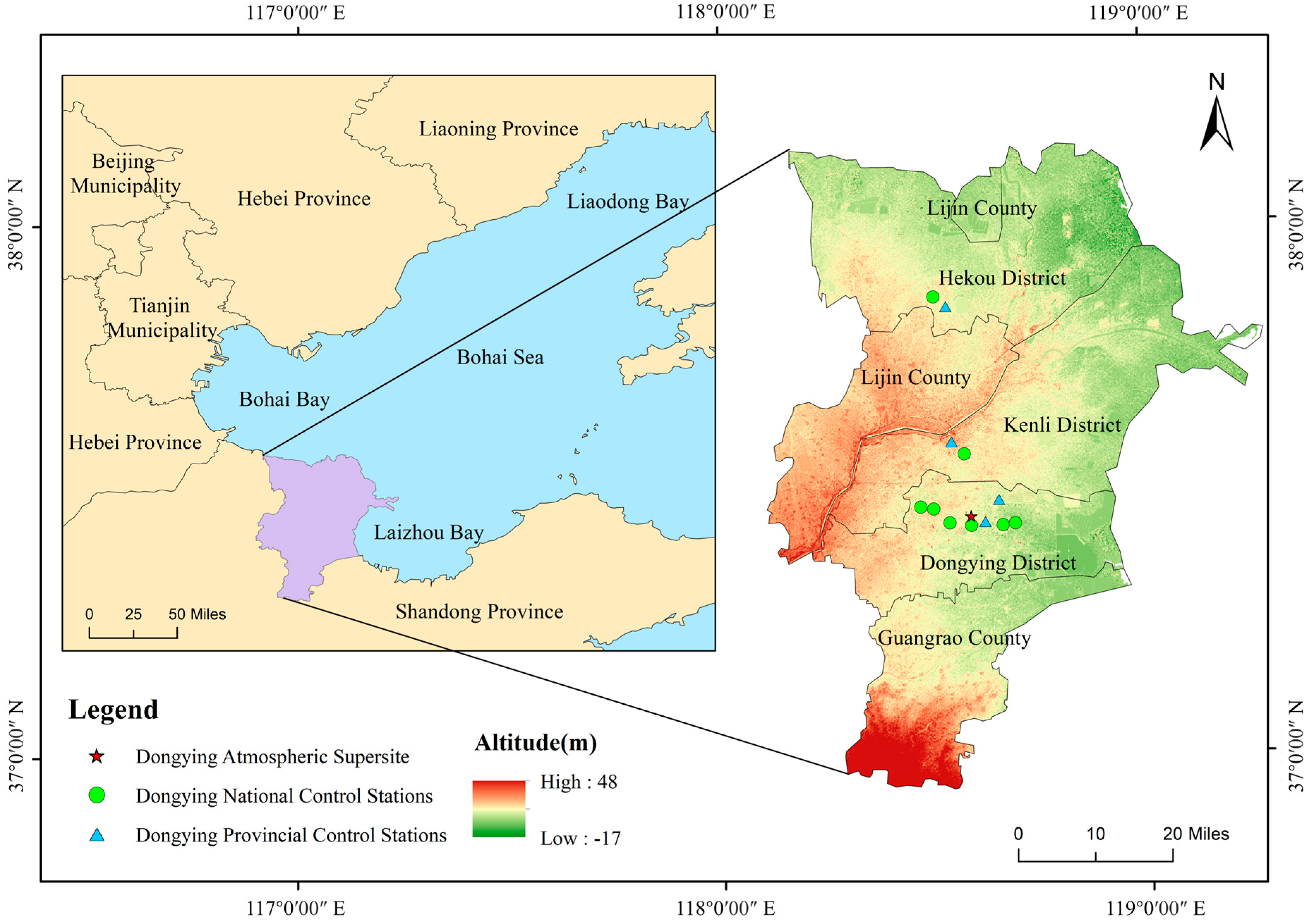
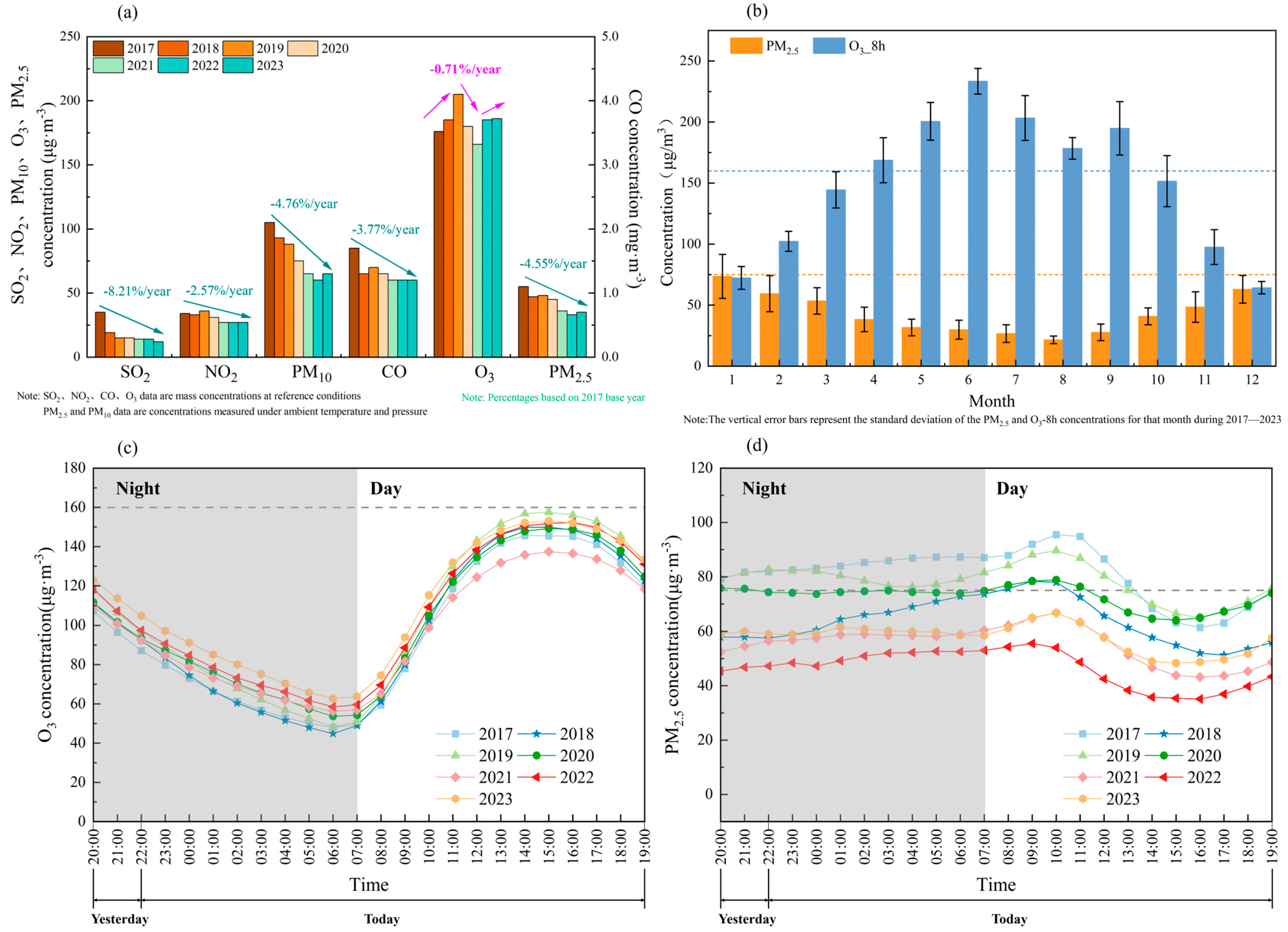
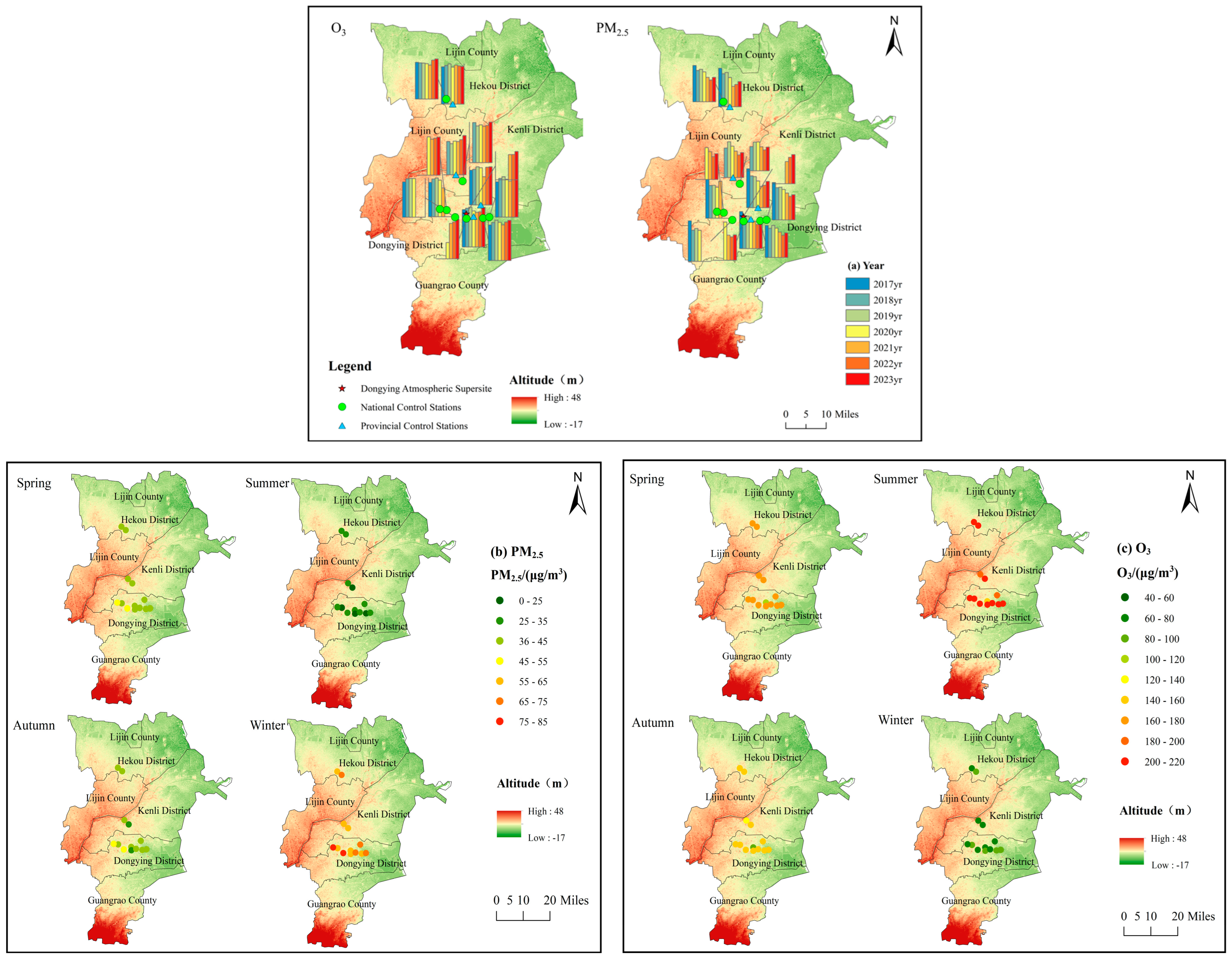
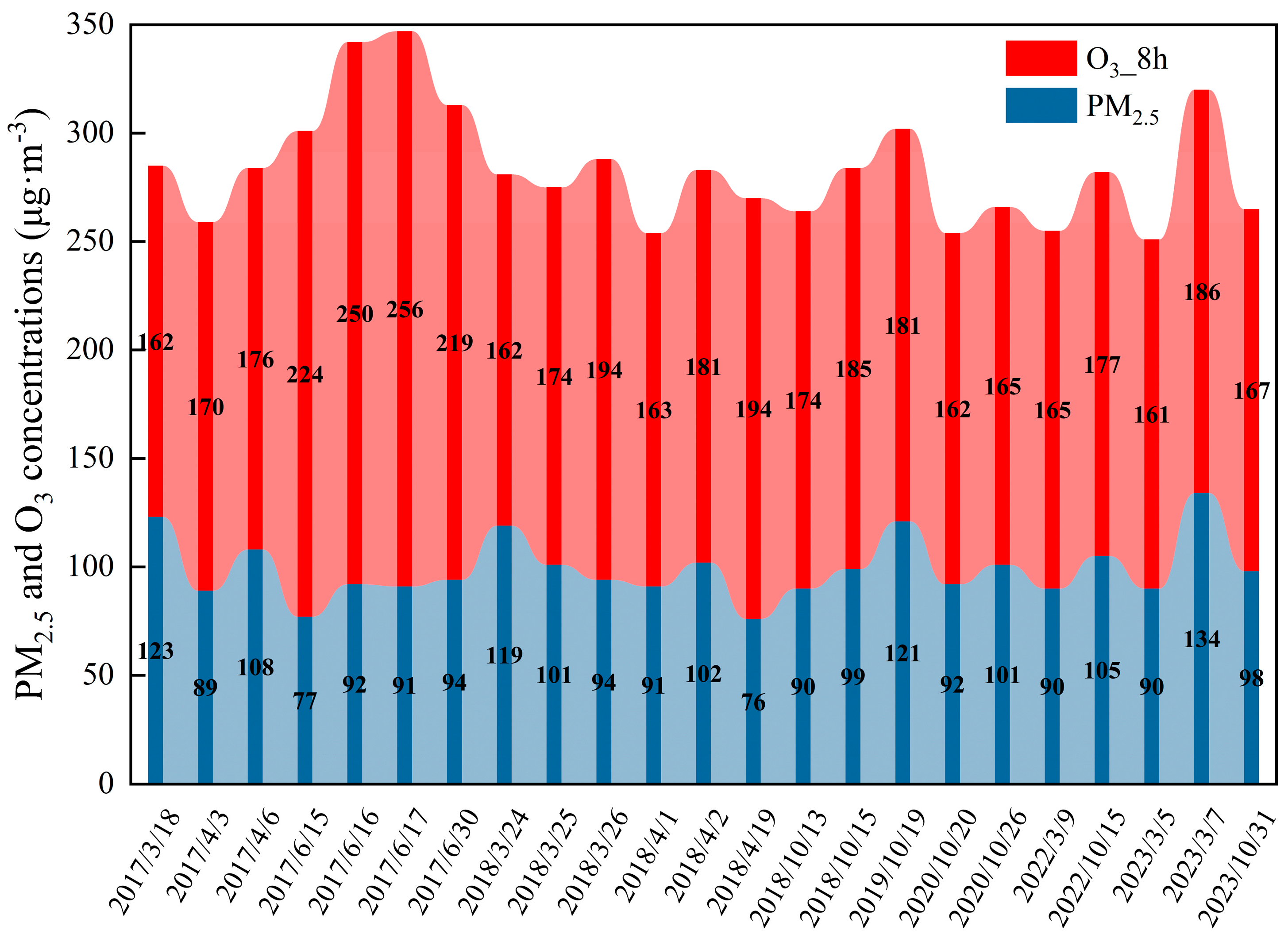

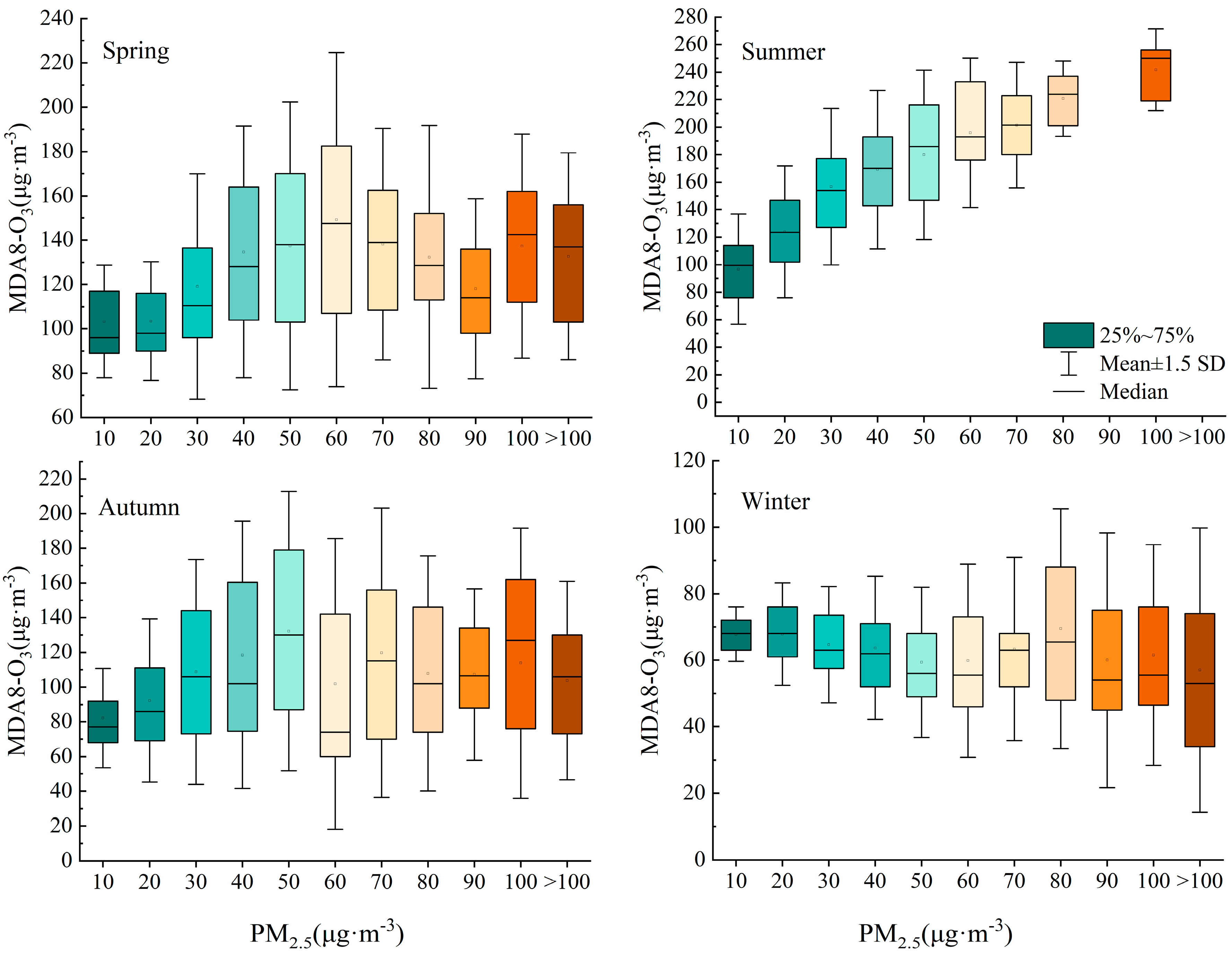
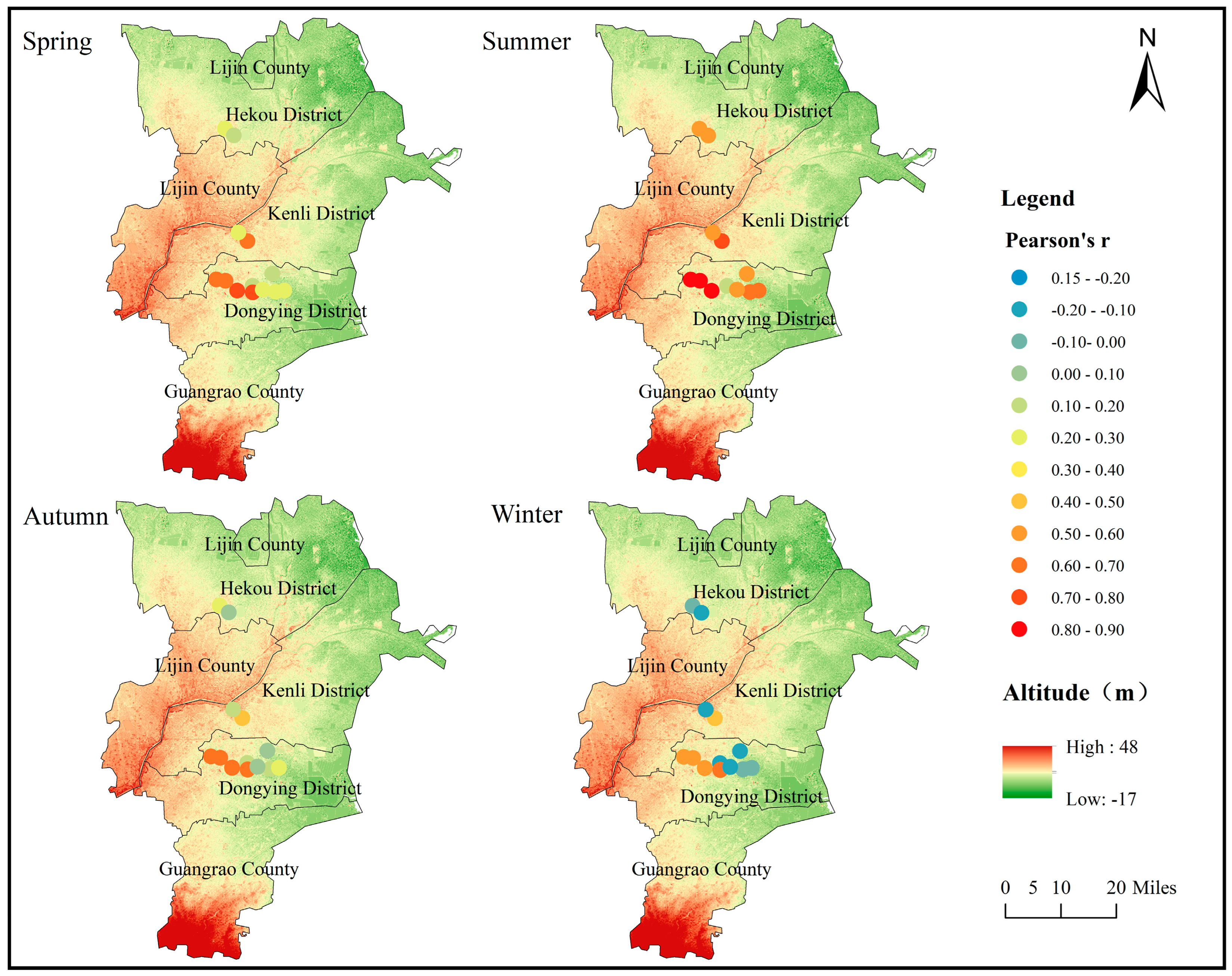
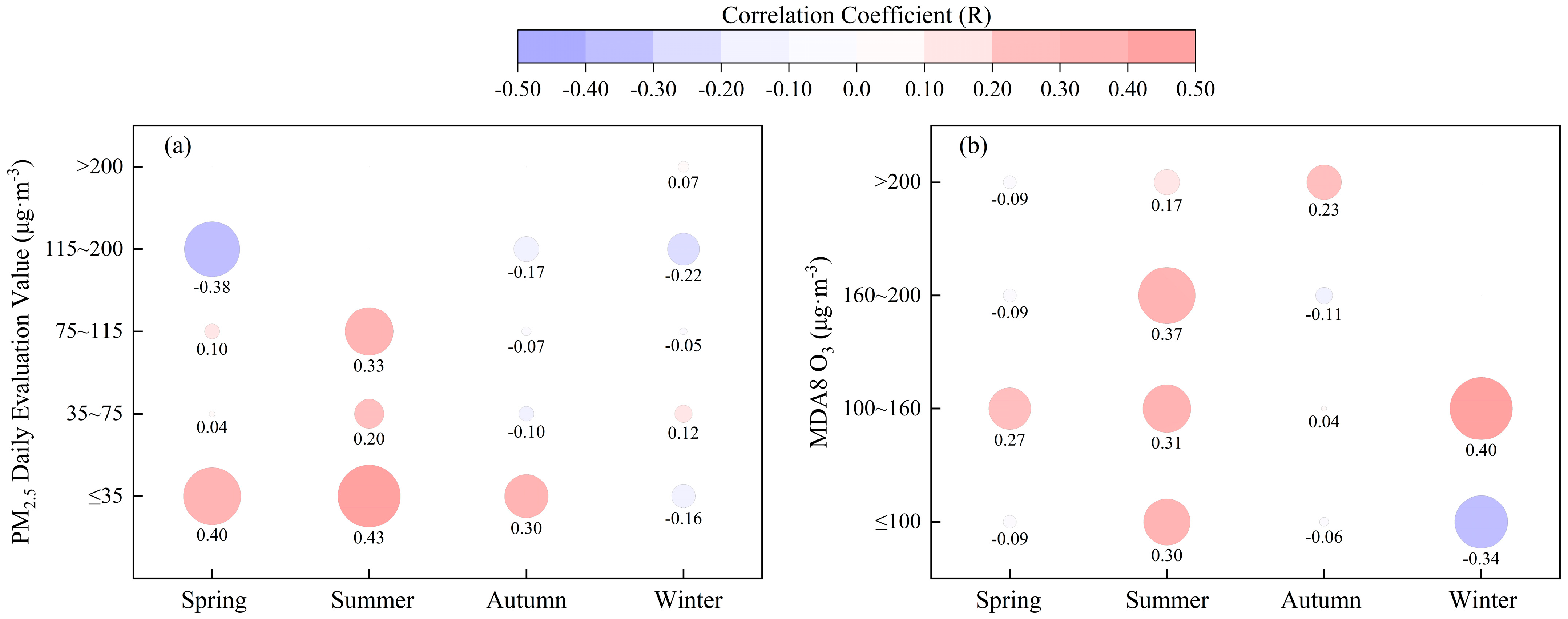
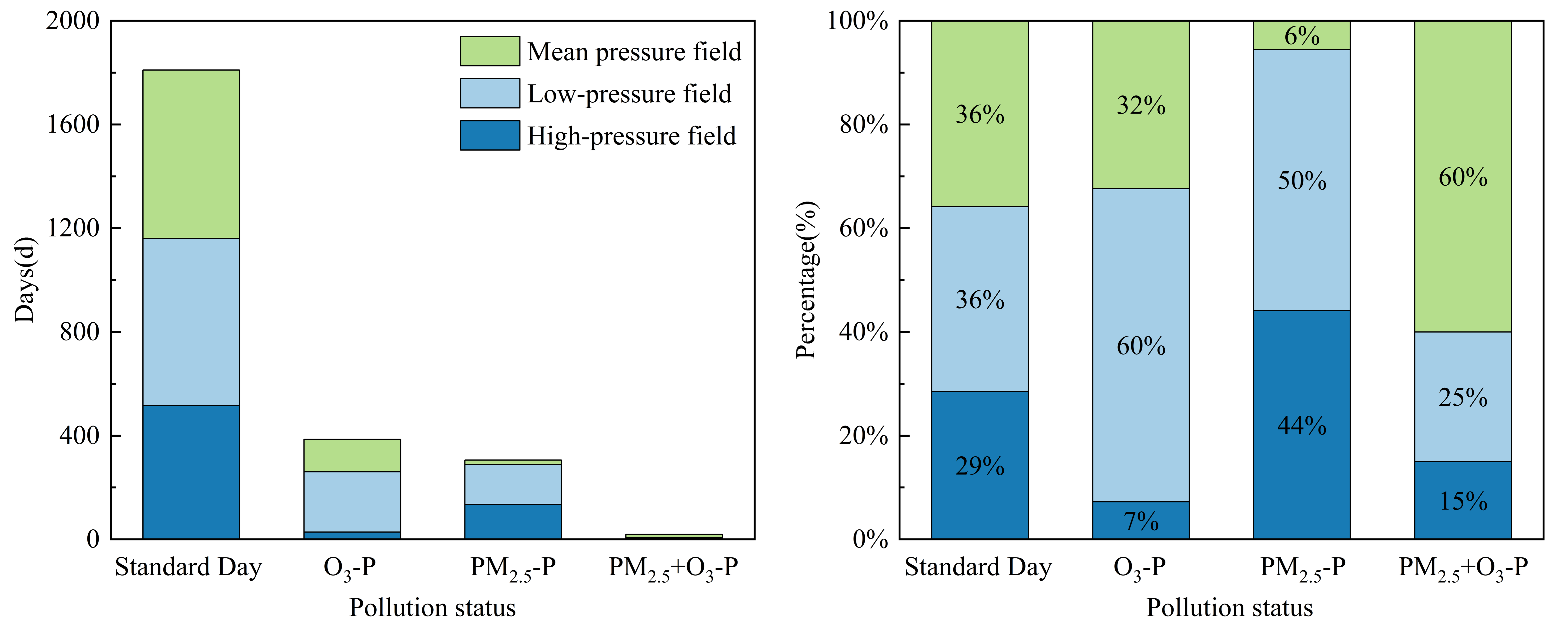
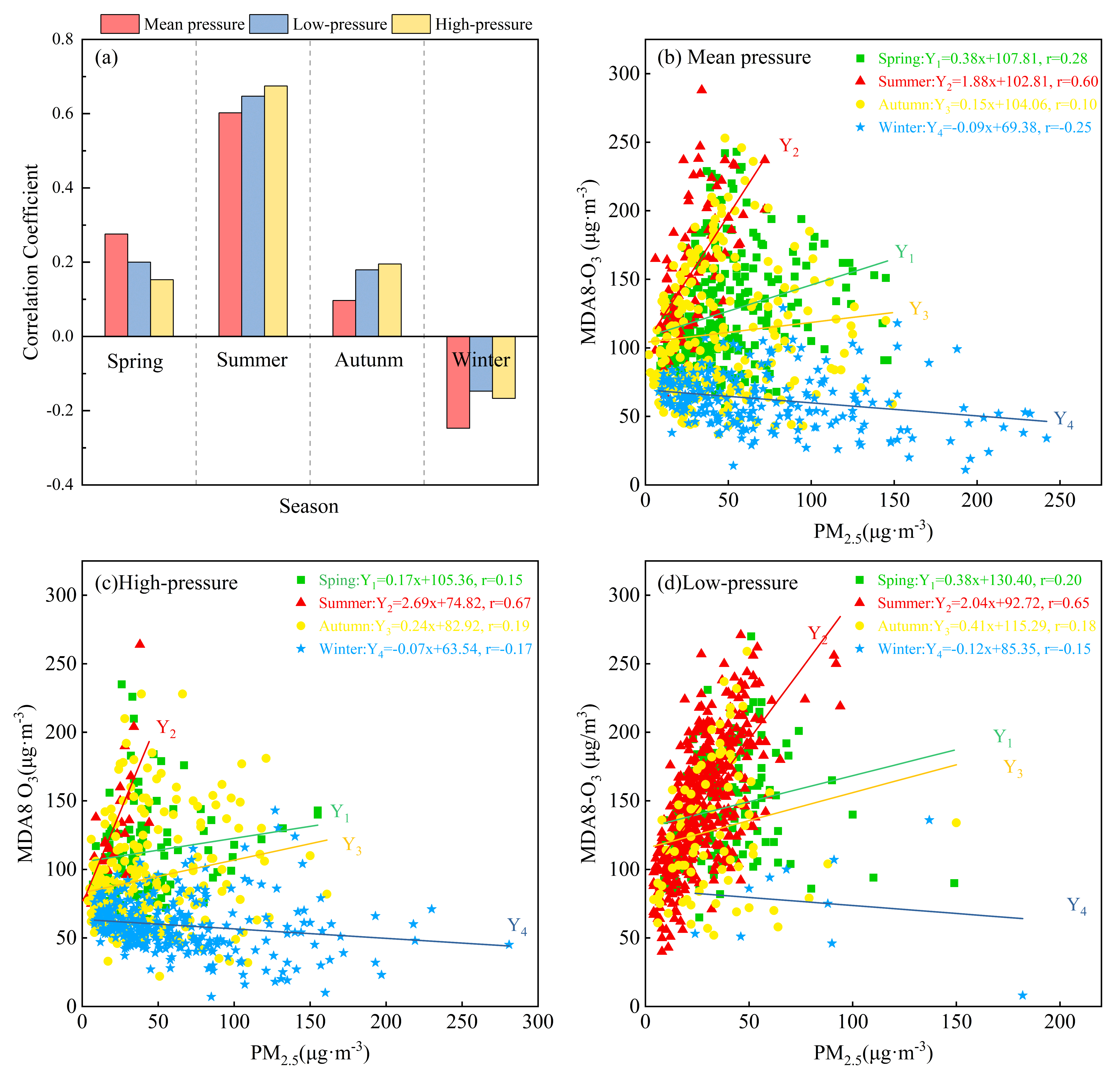
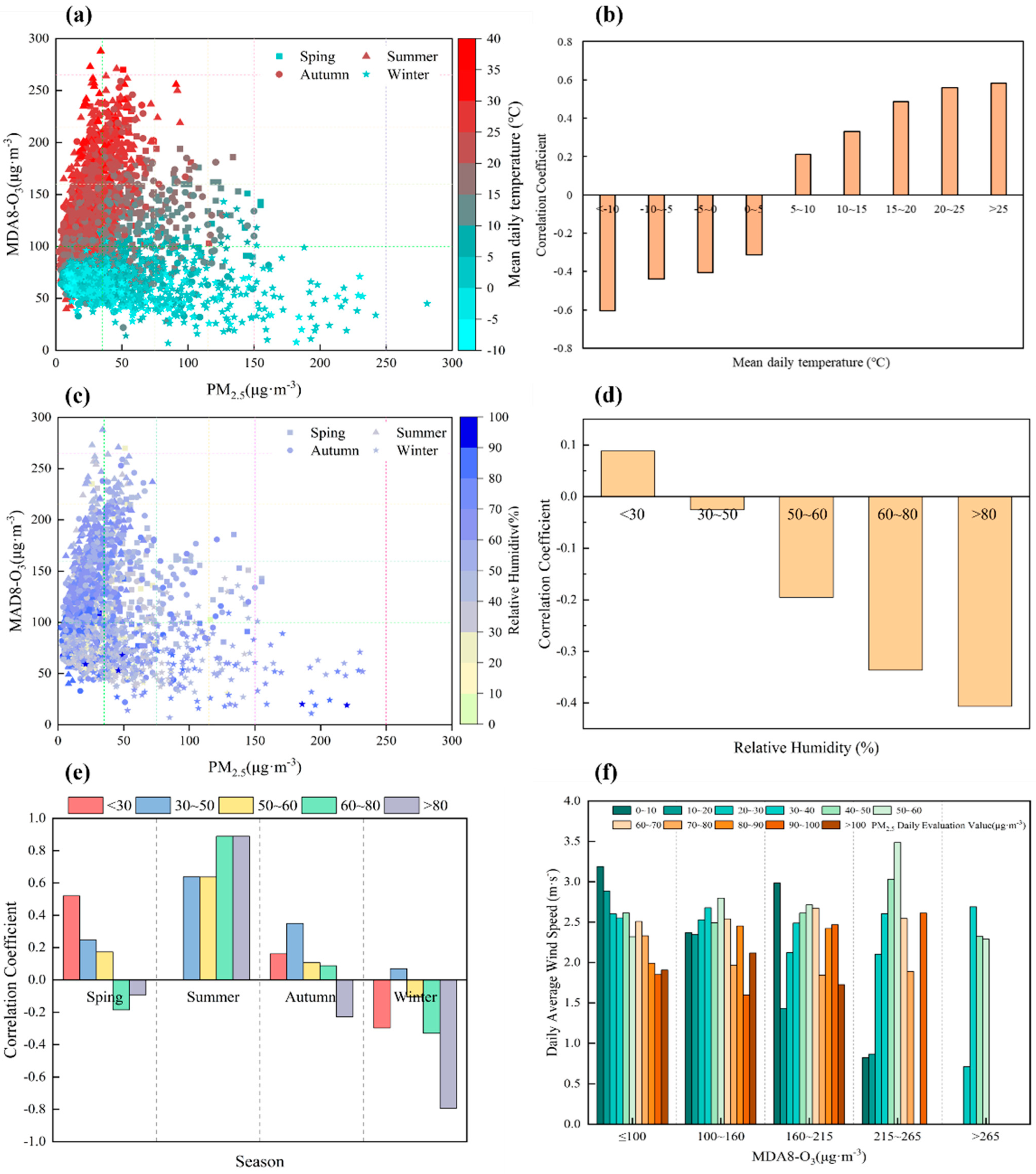
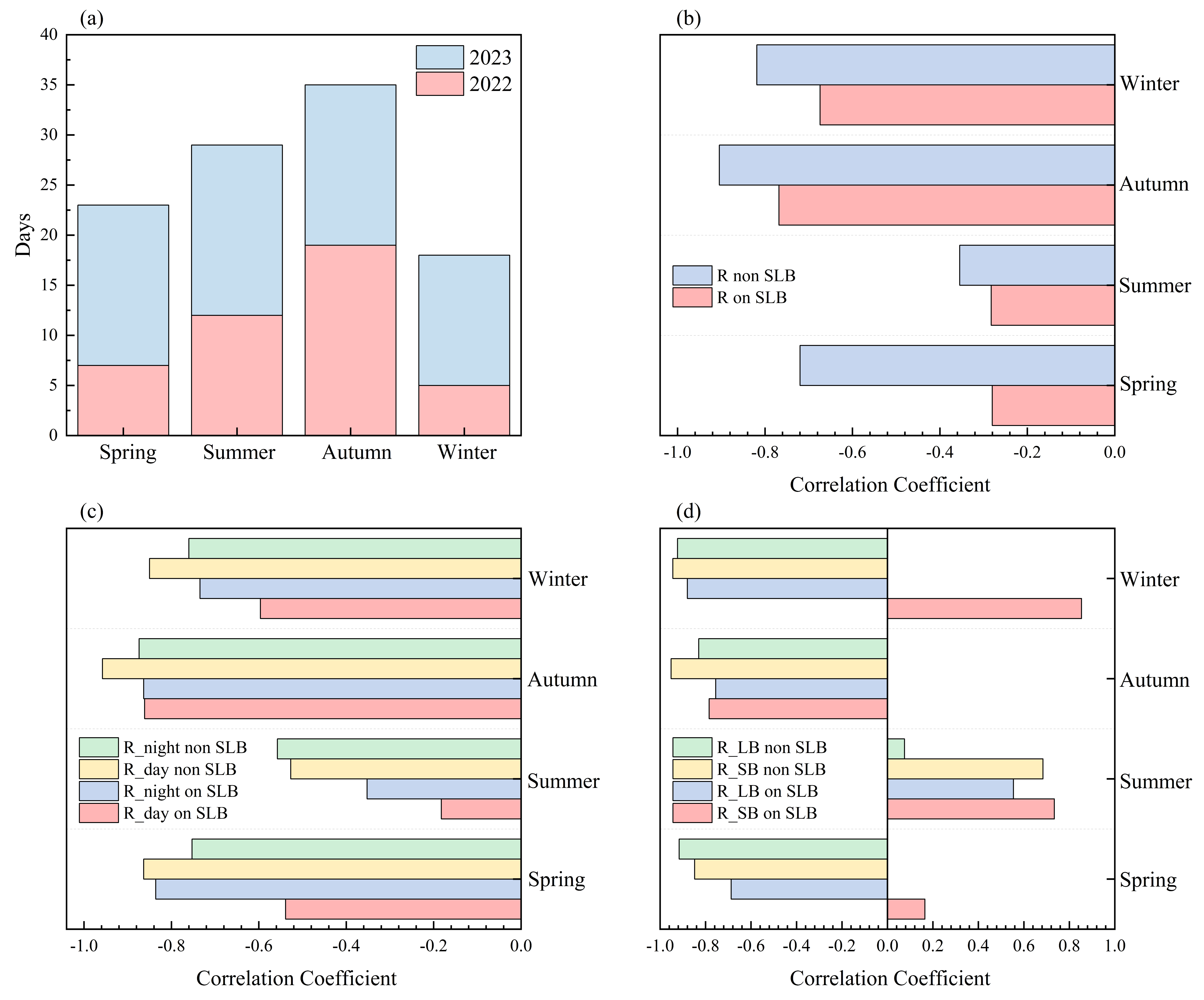
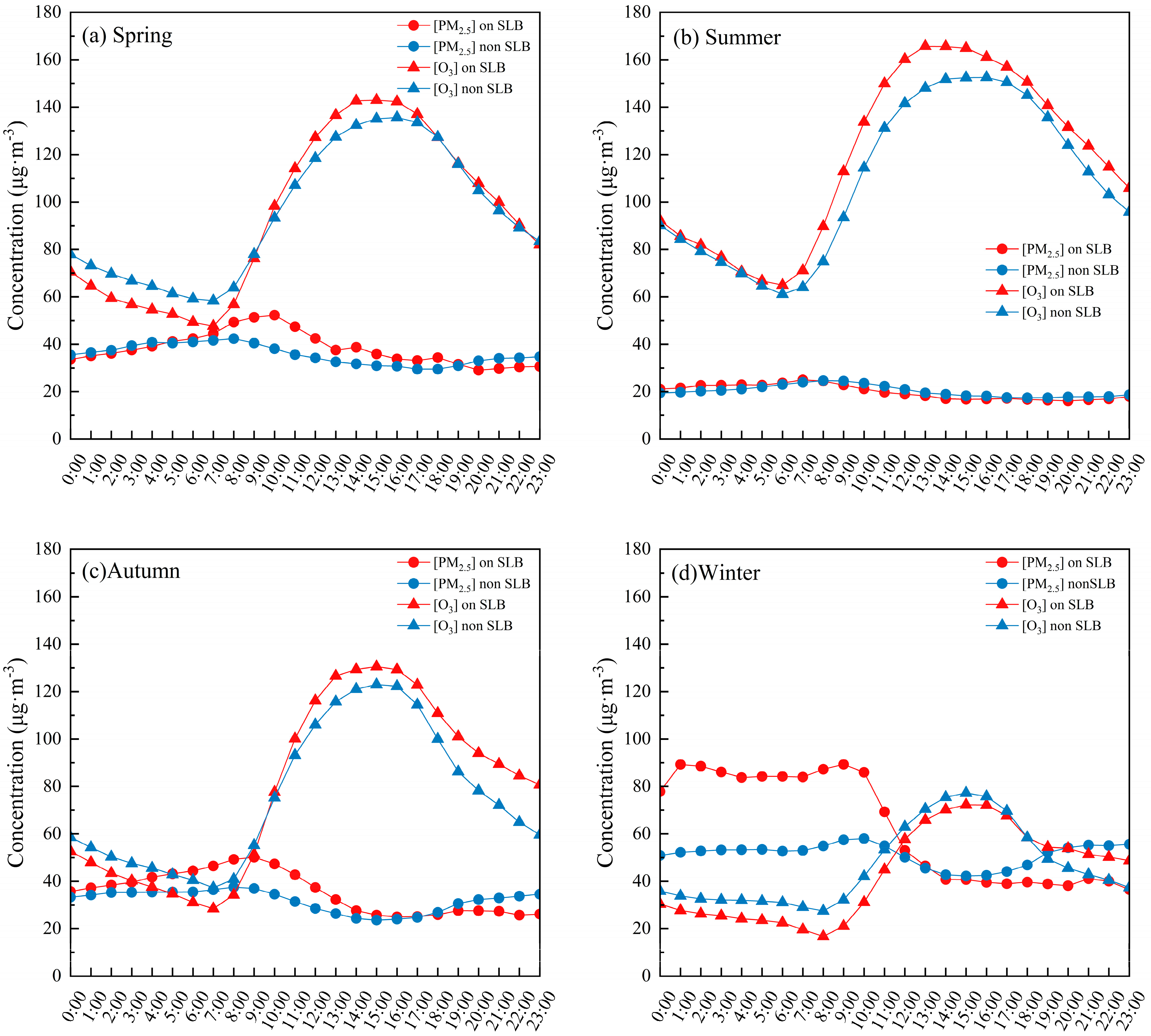
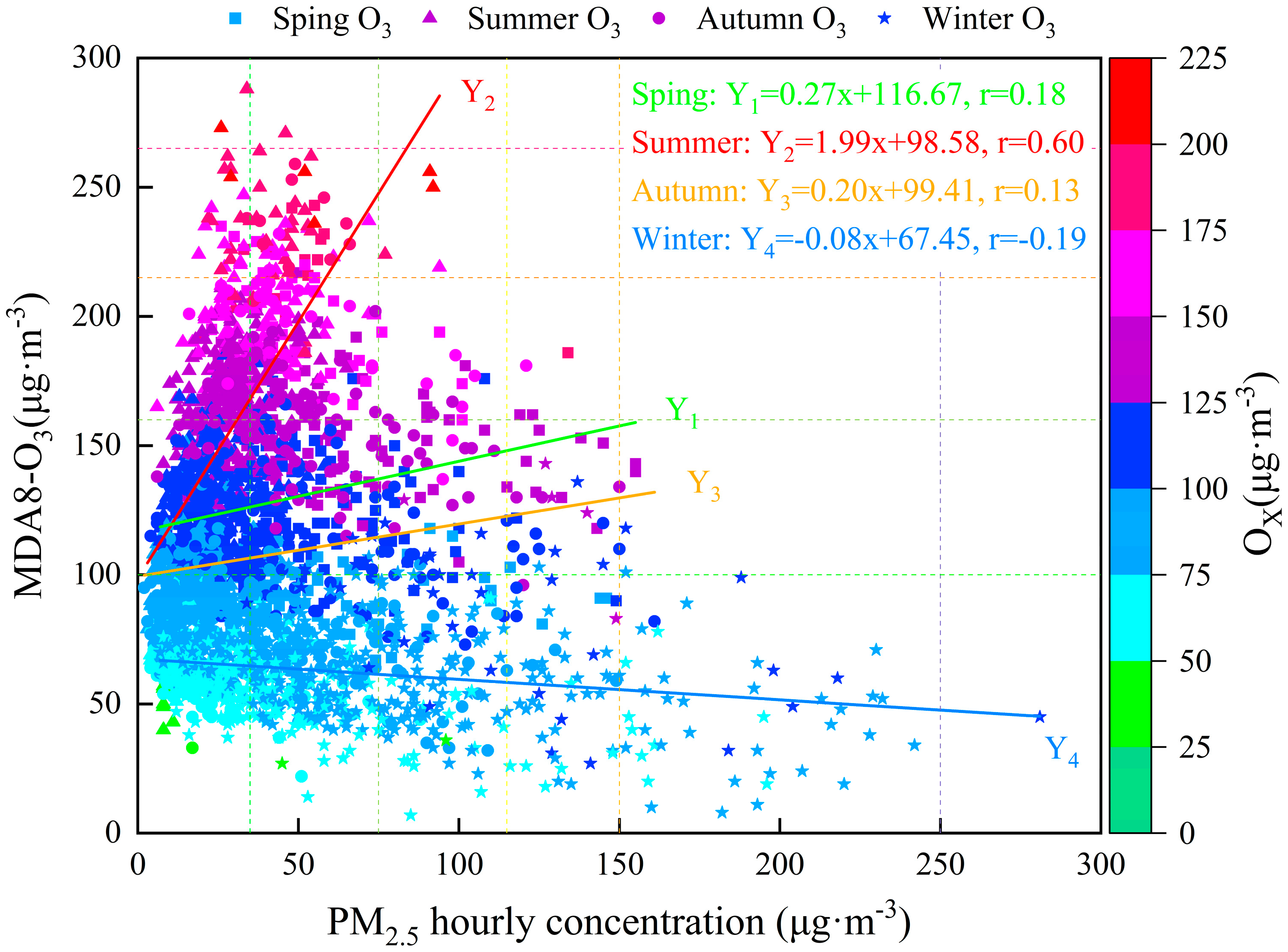
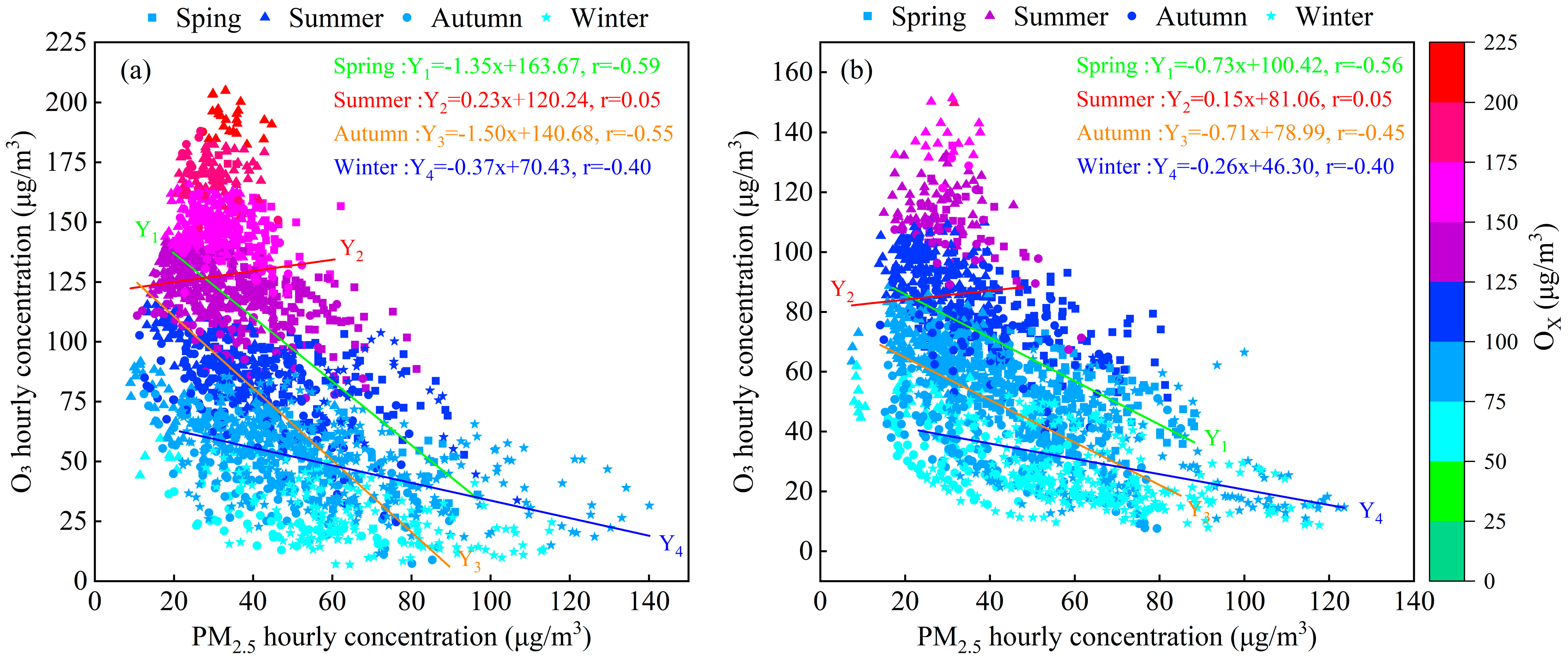
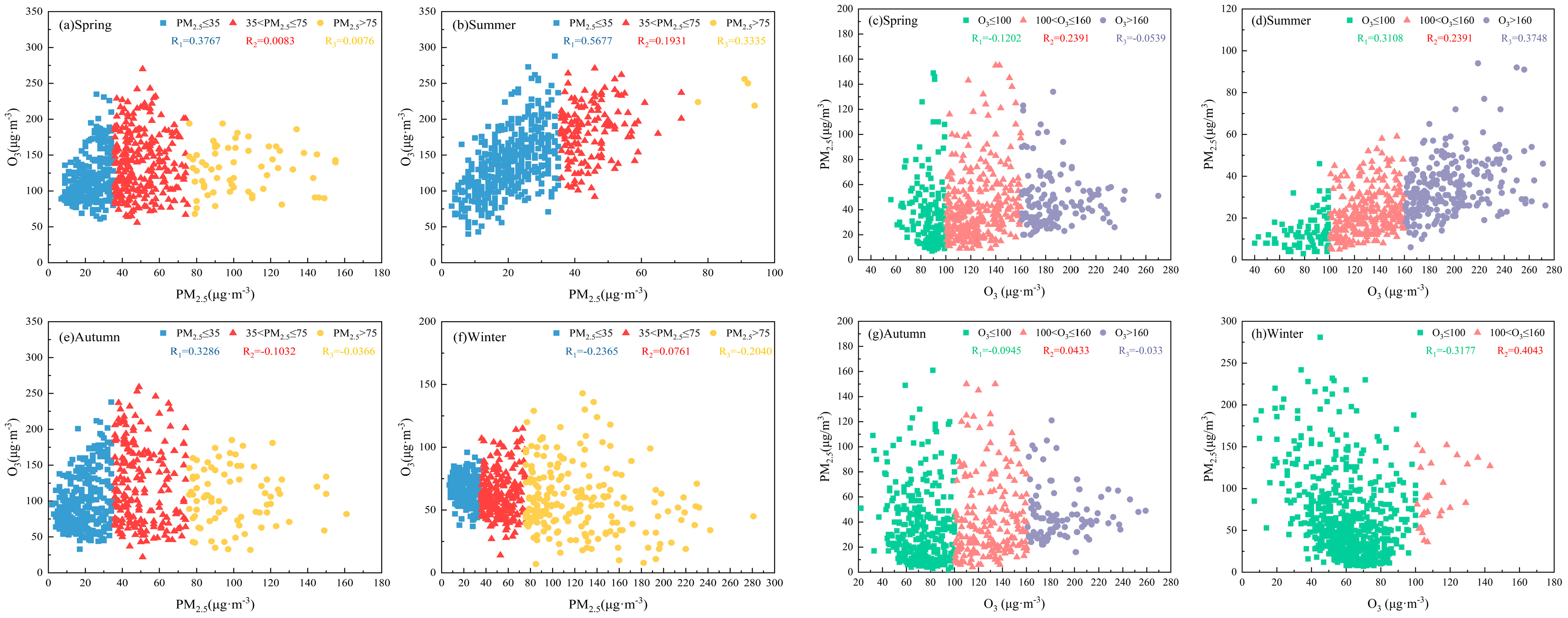
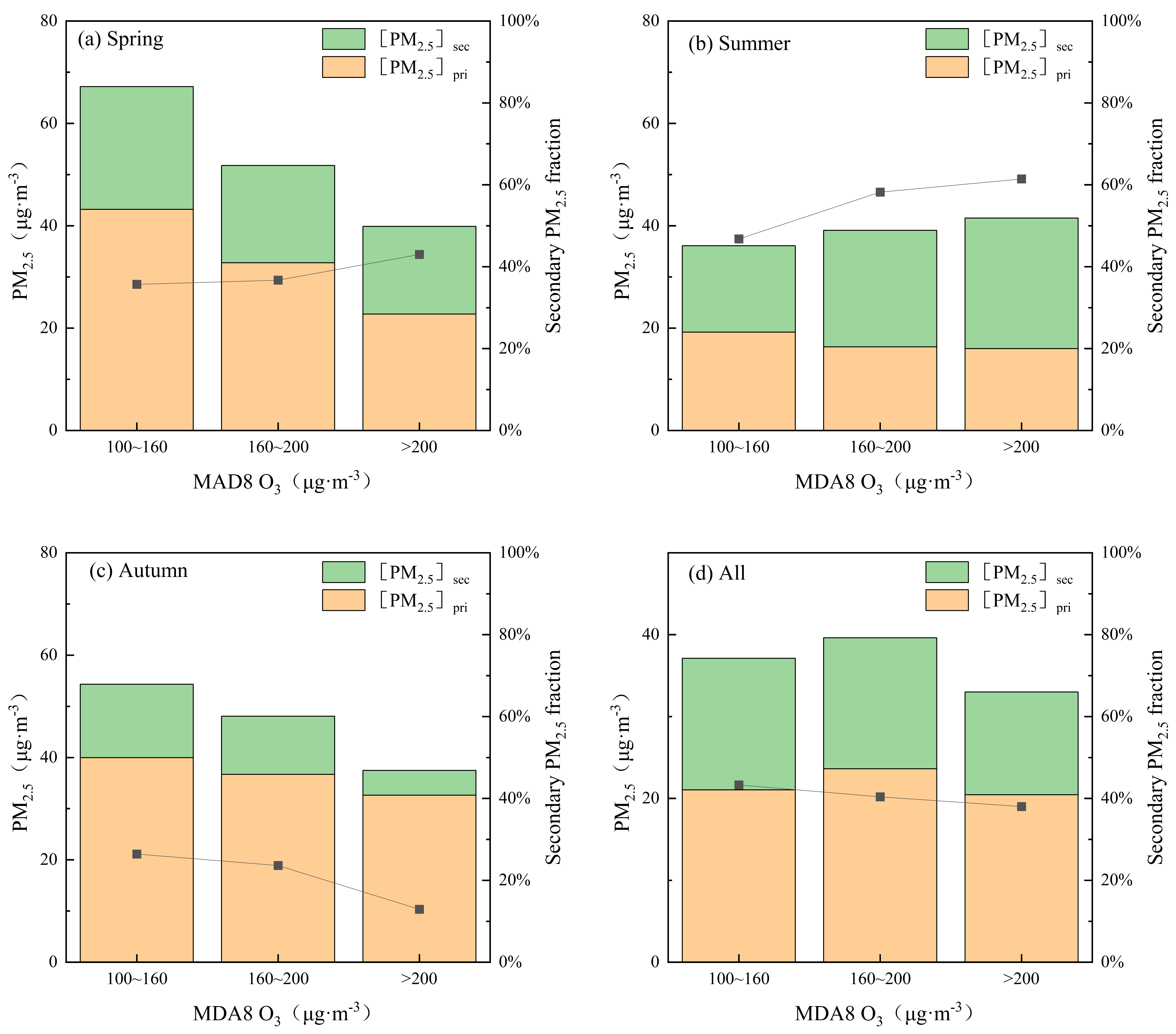
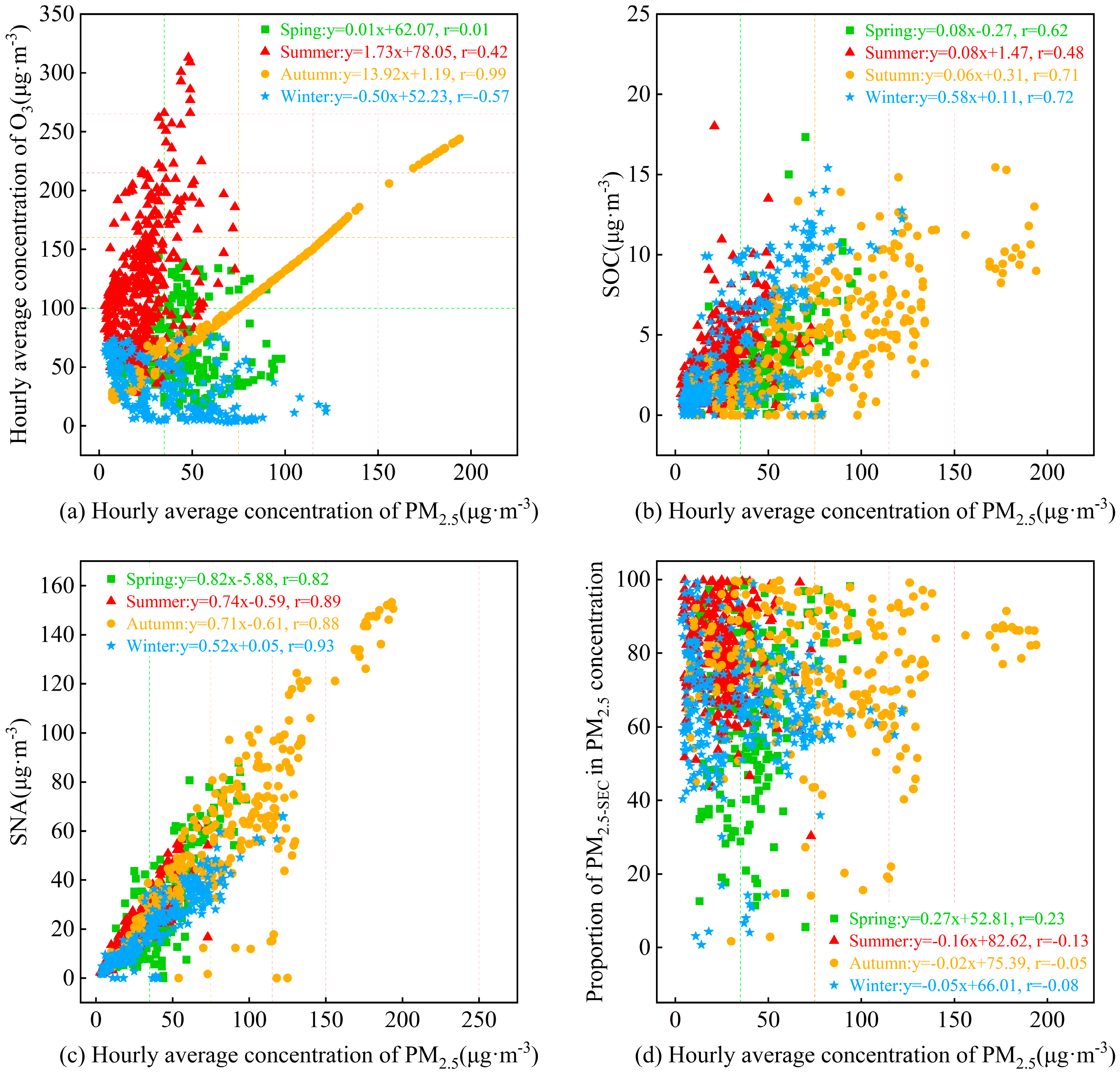
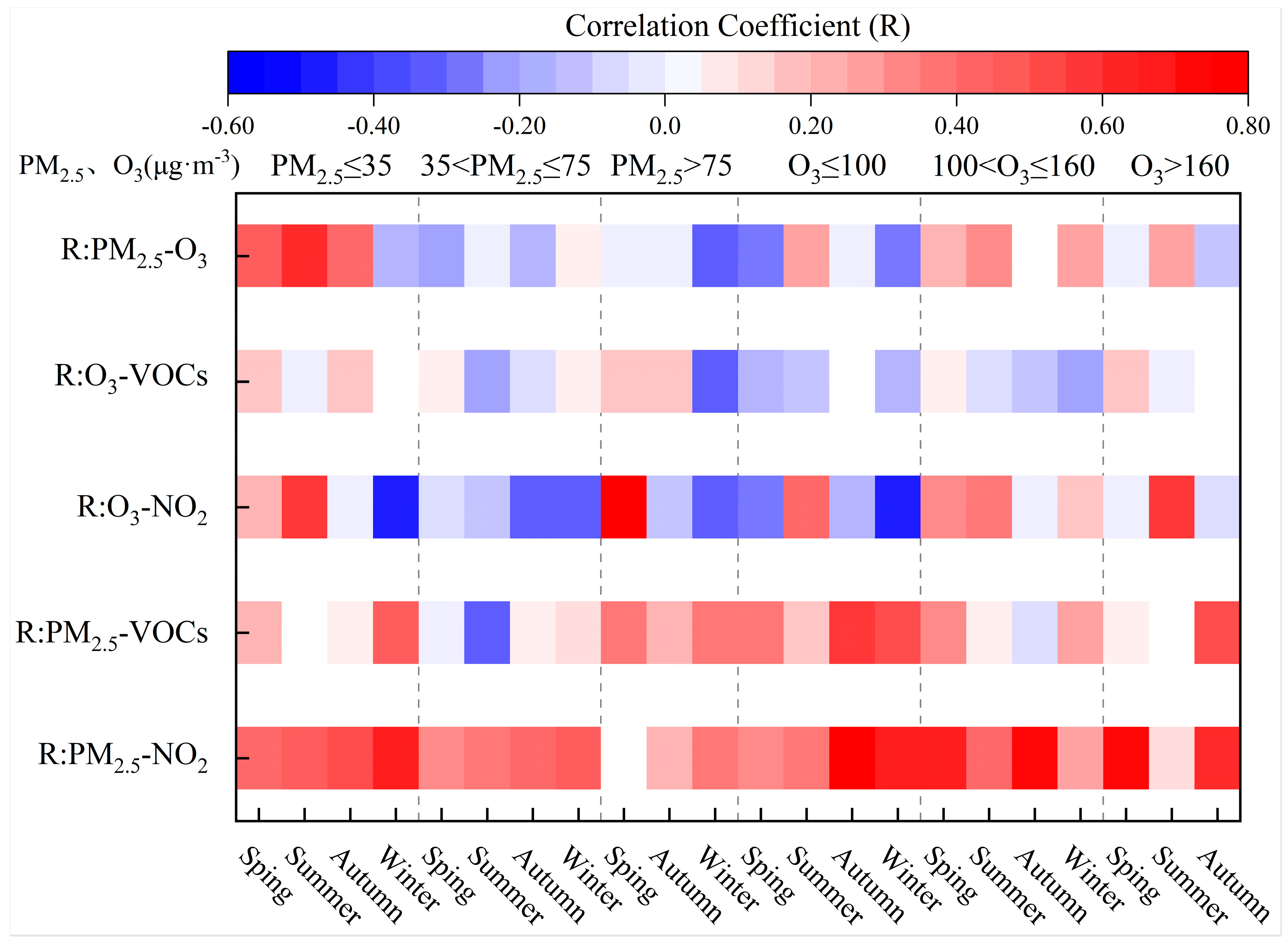

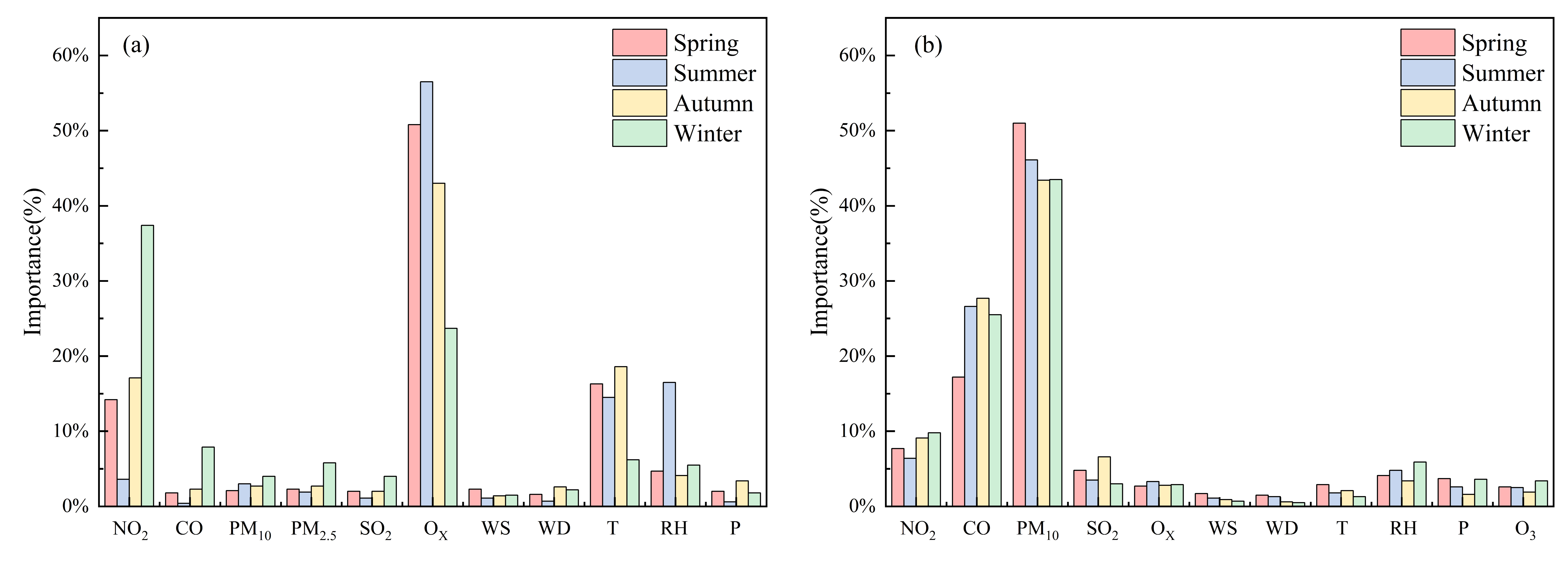
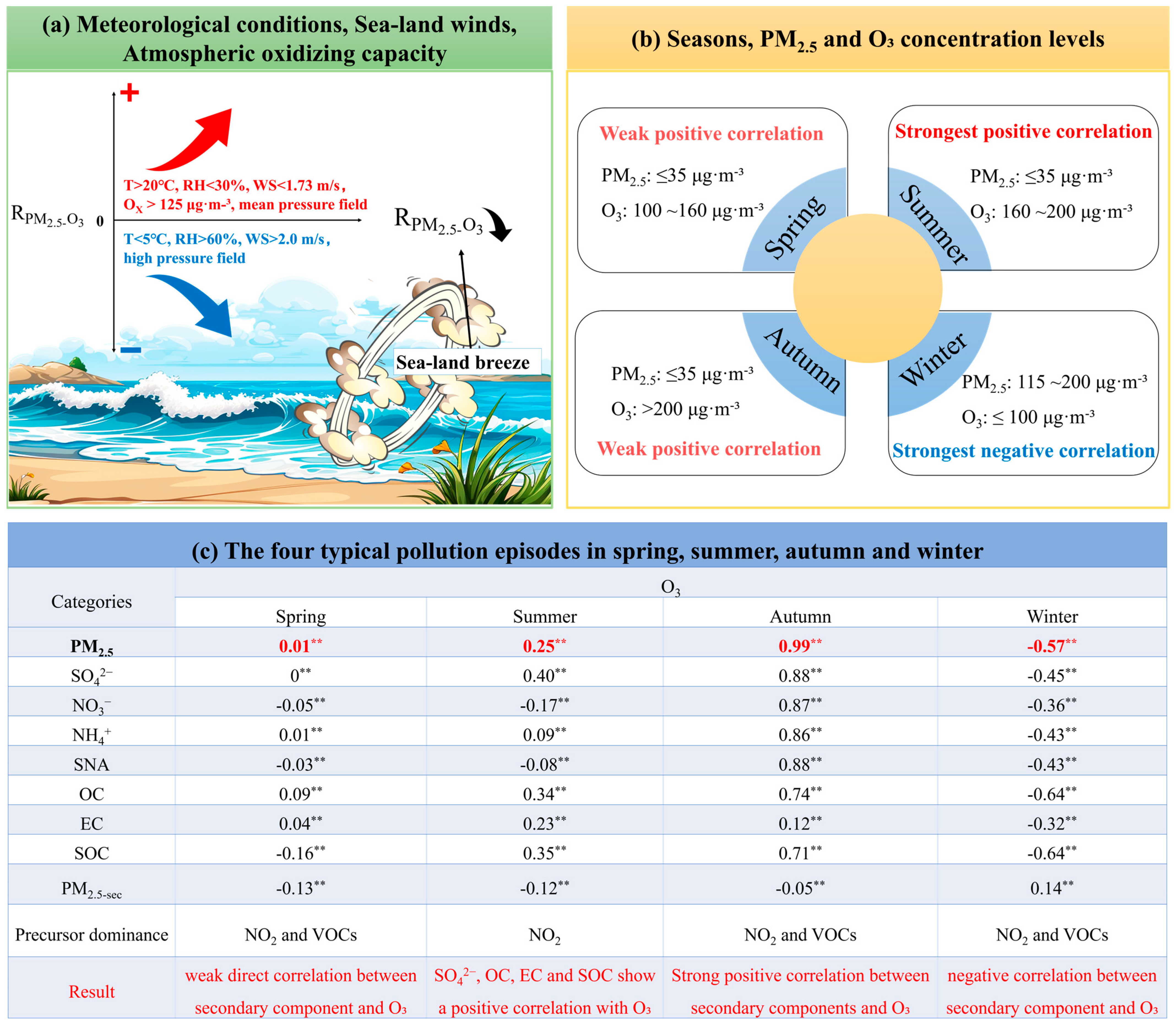
Disclaimer/Publisher’s Note: The statements, opinions and data contained in all publications are solely those of the individual author(s) and contributor(s) and not of MDPI and/or the editor(s). MDPI and/or the editor(s) disclaim responsibility for any injury to people or property resulting from any ideas, methods, instructions or products referred to in the content. |
© 2025 by the authors. Licensee MDPI, Basel, Switzerland. This article is an open access article distributed under the terms and conditions of the Creative Commons Attribution (CC BY) license (https://creativecommons.org/licenses/by/4.0/).
Share and Cite
Nie, Y.; Yan, Y.; Ji, Y.; Gao, R.; Ren, Y.; Bi, F.; Shang, F.; Li, J.; Chu, W.; Li, H. Assessing the PM2.5–O3 Correlation and Unraveling Their Drivers in Urban Environment: Insights from the Bohai Bay Region, China. Atmosphere 2025, 16, 512. https://doi.org/10.3390/atmos16050512
Nie Y, Yan Y, Ji Y, Gao R, Ren Y, Bi F, Shang F, Li J, Chu W, Li H. Assessing the PM2.5–O3 Correlation and Unraveling Their Drivers in Urban Environment: Insights from the Bohai Bay Region, China. Atmosphere. 2025; 16(5):512. https://doi.org/10.3390/atmos16050512
Chicago/Turabian StyleNie, Yan, Yongxin Yan, Yuanyuan Ji, Rui Gao, Yanqin Ren, Fang Bi, Fanyi Shang, Jidong Li, Wanghui Chu, and Hong Li. 2025. "Assessing the PM2.5–O3 Correlation and Unraveling Their Drivers in Urban Environment: Insights from the Bohai Bay Region, China" Atmosphere 16, no. 5: 512. https://doi.org/10.3390/atmos16050512
APA StyleNie, Y., Yan, Y., Ji, Y., Gao, R., Ren, Y., Bi, F., Shang, F., Li, J., Chu, W., & Li, H. (2025). Assessing the PM2.5–O3 Correlation and Unraveling Their Drivers in Urban Environment: Insights from the Bohai Bay Region, China. Atmosphere, 16(5), 512. https://doi.org/10.3390/atmos16050512




